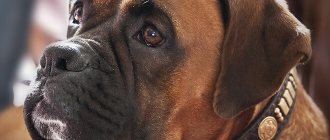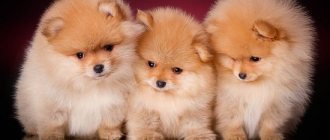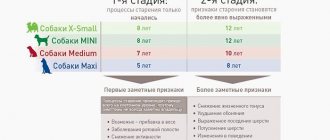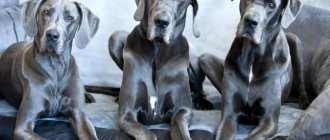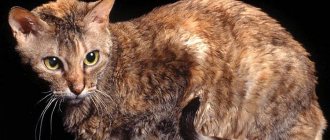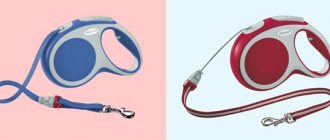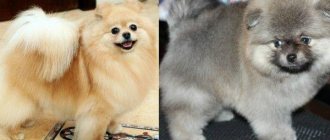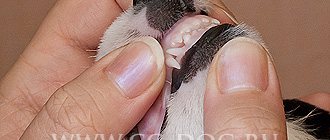History of the origin of the German Boxer breed
The ancestors of the German boxer are Bullenbeissers, which means “bullmen”. They were common in Europe already in the 6th-7th centuries. and were used to hunt forest animals. Fearlessness, endurance, agility, remarkable strength and powerful jaws made them a threat to bears, wild boars, wolves, and bison. By the end of the 17th century, when forest lands began to shrink due to the spread of agriculture, Bullenbeisers mastered the profession of security guards.
The first attempts to develop a new breed began in Munich at the end of the 19th century. It was then that the Bullenbeiser was crossed with the English Bulldog. A significant contribution to the development of the breed was made by dog handler and trainer Friedrich Robert. With a team of like-minded people, he began to make the dream of an elegant, powerful, fit and balanced service dog a reality. The fruit of joint labors - the first boxer Flocky - was presented at the exhibition in 1895.
In 1825, the Russian artist Bryullov depicted Princess Golitsyna in the company of a bullenbeiser
Subsequently, Mrs. Shtokman, the owner of the Von Dom kennel, founded in 1911, played a major role in the development of the breed. All her life she carried out breeding work and became the “mother” of many outstanding sires and champions. For example, her boxer Rolf, a multiple winner of various exhibitions, was called up for military service, from where he returned unharmed and triumphantly completed his exhibition career at the age of 11.
By the middle of the 20th century, German boxers became so popular that the need arose to create an International Association of Fans of the Breed (ATIBOX). It coordinates its further development and unites 25 countries. Today, the German boxer is recognized by all leading cynological associations (CKC, FCI, AKC, UKC, ANKC, NKC, NZKC, APRI, ACR).
In 1925, German boxers received the status of service police dogs, and in wartime they were postmen, scouts, guards and messengers
Story
Back in the 17th century, in Western and Central Europe, people could observe the Bullenbeiser breed, which was the prototype of the “Boxer”.
The German Boxer dog appeared in its current form in 1850 in Munich:
- this breed was developed from mastiffs and bulldogs, used against bulls and other large animals, including bears;
- thus the result was a hunting dog with a strong grip and a fearless character;
- after careful selective selection, specialists managed to produce specimens with a controlled character and present them to the general public in 1896.
The standard for this breed changed in 2002 and 2008.
Description of the German boxer
According to FCI standard No. 144, which came into force on 07/09/2008, the Boxer, or German Bulldog, belongs to Group 2 - “Pinchers and Schnauzers, Molossians and Swiss Mountain Dogs”, Section 2.1 - “Molossians, Great Danes”. Representatives of the breed are used as guard dogs, bodyguards, police officers and guide dogs for the blind.
Appearance of a German boxer
The official standard describes the German boxer as follows:
- height at withers for males - 57–63 cm, for females 53–59 cm;
- weight - 30 kg and 25 kg, respectively;
- the physique is strong, muscular;
- square body;
- the back is short, wide, muscular;
- the chest is powerful, deep, reaching to the elbows;
- tucked stomach;
- the withers are well defined;
- the neck is powerful, long, rounded;
- the skull is narrow, angular;
- the muzzle is voluminous, dry, folds on the forehead appear with increased attention;
- pronounced chin when viewed from the front and side;
- eyes and eyelids dark;
- the ears are undocked and lie on the sides of the skull;
- the transition from forehead to nose (stop) is sharp;
- the nose is wide, black, upturned, the nostrils are open;
- the upper lip is fleshy, completely covering the protruding lower jaw;
- teeth are strong and white;
- the fangs are large, widely spaced, and not visible when the mouth is closed;
- the incisors are arranged in one line;
- limbs are straight, even, parallel to each other, muscular;
- the hind legs are slightly longer than the front legs;
- fingers tightly clenched, pads hard;
- tail of normal length (undocked);
- movements are noble, confident, energetic;
- the skin is elastic, without folds;
- the coat is short, shiny, hard, close-lying;
- color of any shades of red or brindle, a black mask on the face is required.
Photo gallery: appearance of the German boxer
The German boxer is a strong and muscular dog, whose wheel chest reveals his courageous disposition.
Boxer is a handsome brown-eyed man with a black mask on his muzzle and a slightly upturned nose.
Despite the fact that the boxer's lower jaw protrudes forward, the teeth must be covered by the upper lip
The boxer's gaze should not be threatening or ferocious.
According to the standard, the color of a boxer can be any shade of red (from light yellow to red-brown), and white spots on the chest serve as decoration
Brindle coloring implies the presence of dark stripes running along the ribs
Character of a German boxer
The German Boxer is a brave, confident, disciplined dog with a strong nervous system. When surrounded by close people, he behaves spontaneously, playfully, and friendly. The boxer is not prone to aggression, so he will get along well with children and become a cheerful friend for them.
A born leader is unlikely to tolerate cats and small dogs in the same territory. The exception is pets who grew up with him. He treats strangers with suspicion and, if necessary, will selflessly protect members of his “pack.”
The boxer cannot stand loneliness, loves to be in the thick of things and is ready to accompany his owner-leader on any hikes and trips. The cheerful dog is only too happy to throw out his unbridled energy. The boxer remains inquisitive and active until old age.
The German boxer loves children very much, but it is important that in the family hierarchy he puts them above himself
Disqualifying faults of a German boxer
Disqualifying faults of the German Boxer breed include:
- cryptorchidism (undescended testicle into the scrotum);
- white and spotted colors;
- lower jaw teeth protruding from under the upper lip;
- malocclusion;
- weak, narrow lower jaw, its distortion;
- insufficiently massive chin;
- bifurcated nose and/or cleft lip;
- depigmented eyelids, nose, lips;
- amble.
According to the decision of the FCI General Committee made in March 2016, dogs from countries where ear and tail docking are prohibited by law will not be able to participate in international exhibitions. Russia is not yet one of them.
Thanks to Greenpeace activists, docking of dogs' ears and tails is prohibited by law in many civilized countries.
Peculiarities
The description of a boxer dog is as follows:
- height at withers 53-63 cm;
- weight of a large individual is 25-30 kg;
- the body has the shape of a square;
- the chest reaches the elbows;
- a clear ratio of the length of the muzzle and skull is 1:2.
Choosing a German Boxer Puppy
When choosing a four-legged friend, pay attention to:
- reputation of the nursery;
- pedigree and titles of parents, their compliance with the standard;
- appearance and behavior of the puppy - it must be active, friendly, sociable, well-fed, with healthy teeth, fur, clean eyes and ears;
- availability of a full package of documents (metrics, veterinary passport with vaccination and deworming marks, purchase and sale agreement).
Prices for German Boxer puppies depend on the class:
- companion animals cost from 5 thousand rubles;
- babies for breeding - from 15 thousand rubles;
- future champions - from 30 thousand rubles.
Red puppies are cheaper than their brindle counterparts
Training and education
The German boxer is very smart and easy to train. Only natural stubbornness can interfere with the learning process, so the owner will have to show patience and perseverance:
- The boxer loves to dominate. It is important to instill in him from childhood who is boss in the house.
- Determine the boundaries of what is permitted, do not allow biting hands even during play, or chewing furniture, shoes, baseboards, but leave the opportunity to explore the surrounding space. Distract with toys and spend more time so that the puppy does not get bored.
- From 2 months of age, accustom your baby to a collar and leash.
- From 3 months, start socializing your Boxer and taking short walks (15 minutes each). This way he will get used to city noise, crowds of people and other dogs.
- Master the simplest commands in a playful way (“Sit!”, “Near!”, “Come to me!”, “Ugh!”), not forgetting to reward with treats and praise. Periodically repeat what you have learned, because some knowledge from a child’s memory may fade away.
- It is prohibited to use physical methods of punishment, otherwise the dog will become cowardly or embittered. It’s better to say in a stern voice: “You can’t!”
- From six months, master sports disciplines, for example, agility (overcoming an obstacle course) or obedience (obedience course).
Up to a year, physical activity should be dosed, since during this period the formation of the cardiovascular and musculoskeletal systems occurs. Strength training (for example, towing a skier) for males can be started after two years, for females - after the first mating. This will help develop powerful breasts.
At 5 months of age, the puppy gains self-confidence, some independence and begins to show stubbornness and disobedience.
Feeding a German boxer
The German Boxer is an active dog, so its diet should consist of 2/3 protein. Among the permitted products:
- rabbit, chicken, beef (frozen or boiled, boneless);
- boiled fillet of lean sea fish;
- eggs (2 times a week);
- cottage cheese, kefir;
- brown rice, buckwheat;
- seedless vegetables and fruits (except citrus fruits and legumes);
- vitamin and mineral complexes;
- fresh water.
A German boxer should not be given food from the master's table, confectionery, smoked meats, spicy, salty, fatty, or fried foods. You should not overfeed your dog - two meals a day are enough. The optimal serving size is 20% of the animal's weight. German Boxers are prone to gastric volvulus, so they need to rest after a meal.
There is no need to grind the meat: the boxer must tear it to train the jaws
When choosing industrial feed, opt for premium or super-premium products:
- Royal Canin Boxer Adult;
- Acana Heritage Sport & Agility Grain Free;
- Orijen Original Grain Free;
- GO! Fit + Free Dog Chicken, Turkey, Trout Grain Free;
- Grandorf Adult Maxi Lamb & Rice.
Photo gallery: industrial food for the German boxer
Royal Canin Boxer Adult food is designed taking into account the jaw structure of the German boxer and ensures healthy cardiovascular and muscular systems
Acana Heritage Sport & Agility Grain Free food is suitable for active and athletic dogs
Orijen Original Grain Free contains meat, cartilage and by-products necessary for the German Boxer
Food GO! Fit + Free Dog Chicken, Turkey, Trout Grain Free suitable for puppies and adult boxers
Grandorf Adult Maxi Lamb & Rice food is designed for large breed dogs
Breed standards
Every breed of dog has its own characteristics and characteristics. Boxers are no exception. Let's talk about some of them in more detail.
Head
The volume of the pet's skull is proportional to the size of the body. They have developed parietal muscles. The frontal bone is convex. When aggression occurs, the forehead wrinkles and becomes covered with skin folds. The nose is large and well developed.
Eyes
The pet's eyes are not large, dark, with eyelids framed in black. The look is friendly, intelligent and wary.
Ears
Ears – look at each other, set high and wide. Uncropped ears are of medium length, mobile, attached to cartilage. When you have an aggressive attitude and show interest in something, your ears go up.
Jaws
The upper jaw is rounded and slightly shorter than the lower jaw. It protrudes over it by 1.5-2 cm, gradually rises upward, forming a wide and strong chin.
Torso
The body is square, muscular and well defined. The chest is significantly larger from the head. The length of the body is approximately half its height.
Neck
Long, dry, with a strong and muscular nape. It is slightly longer than the head itself. There are folds of skin on the throat.
Tail
Docked with a high setting. Number of vertebrae – 2-3 pcs. When moving and showing aggression, slightly raised along the topline.
Paws
The paws are not large, but powerful. The front ones are smooth, parallel to each other with a large, pronounced bone. The hindquarters are smooth and have well-developed muscles.
Wool
The coat is dense, straight and short. The hair on the rump, nape and back is slightly longer than on the body.
Color
Color - various shades of red. The back is brindle. White spots on the face, chin and neck are acceptable. Regardless of the general color of the muzzle, the pet has a black or dark brown mask. Glasses in the eye area are the same color. The nose is powerful and black.
Keeping and caring for a German boxer
The German boxer can be kept in an apartment or a private house. It is not intended for an aviary - it is too sociable and heat-loving. A strong and energetic animal must be walked twice a day for 1.5–2 hours. A simple jog is not enough, so supplement it with fetching. In winter, a boxer needs to be dressed in overalls, because short hair does not warm at all. In hot weather, it is better to refrain from walking: the dog runs the risk of heatstroke.
To prevent your boxer from catching a cold during a winter walk, give him a warm overall or down jacket.
Caring for a boxer comes down to the following procedures:
- Short hair needs to be brushed during seasonal shedding. The rest of the time, to remove dead hair, wipe the dog with a damp towel or massage with a rubber glove.
- You need to bathe your pet 2 times a year, using special shampoos for short-haired dogs (for example, Iv San Bernard ISB Gingko Biloba, RolfClub Keratin+ Complex Shiny, Api-San Royal Groom Shine and Moisturizing, etc.).
- After walks, wipe your paws and apply moisturizer to your pads.
- It is enough to brush your dog's teeth once a week. Alternatively, you can give her tendon bones.
- Shorten the claws with a nail clipper 2 times a month.
- Clean your eyes daily with a cotton pad.
- The drool, foam and bubbles that boxers produce should also be removed with a damp cloth.
- Clean your dog's ears weekly, especially if they are undocked. In this case, the sinks are not ventilated and can become a breeding ground for pathogens that provoke the development of infections.
- Carry out deworming once every 3 months.
- Visit your veterinarian every six months and vaccinate your pet on schedule.
Features of care
Combing
For this procedure, you need to purchase a brush with stiff bristles and carefully comb the dog’s fur a couple of times a week.
The brush can be replaced with a hard cloth. The Furminator should not be used.
There is no need to bathe your dog often; a boxer can be compared to a cat in terms of cleanliness.
Therefore, for your pet, a comprehensive bath with shampoo can be an annual one-time event.
Once every 1-2 weeks it is necessary to trim the nails. In boxers they are not black, so this process is not labor-intensive, but very necessary for dogs.
After all, untrimmed claws wear off on their own, and often not in the most favorable way.
In general, boxers' paws are very delicate and easily wounded, so it is imperative to inspect them after each walk in order to promptly disinfect wounds and abrasions.
The ears and eyes are usually clean, so they do not deserve special attention.
The German Boxer is a very clean dog.
Walk
Looking at the sporty exterior, it’s easy to guess how active a boxer dog likes to be; videos from both professionals and amateurs once again confirm this.
About what is better to choose: a harness or a collar:
Such dogs need physical activity as well as good nutrition. A regular walk will not be enough for them.
Since discipline is everything for a boxer, it is necessary to develop a clear schedule and schedule for his walks.
The best option would be morning and evening for 30-40 minutes. It’s good if you can take a walk in different places with different types of soil.
These activities should definitely include games like agility and training.
Boxers are like children - they love to frolic
Nutrition
Feeding schedule by age:
- 5-3.5 months – 4 times a day
- 5-12 months – 3 times
- 1-1.5 years – 2 times
- From 1.5 years you can feed once a day depending on the dog’s physical activity
If dry food , make sure that it contains the required protein content - at least 30%.
This indicator can be increased if the dog is exposed to intense physical activity, is pregnant or is still a puppy.
When choosing a natural type of nutrition, the protein balance should also be 1/3 of the total diet.
Make sure the food is not too cold or hot.
If your dog eats very quickly, we recommend reading this article on how to wean it:
After eating, do not let your dog be active for a couple of hours to avoid digestive problems.
For the puppy to develop properly, you need to carefully monitor its nutrition.
A dog's natural diet may consist of:
- Boiled lean beef and offal.
- Boiled sea fish, from which the bones must be removed.
- Raw liver.
- Semolina, pearl barley, vermicelli.
- Various vegetables (except starchy ones).
- Cottage cheese.
- Stale bread.
Read more about what cereals can be given to dogs:
It is strictly forbidden to give:
- Sausages, sausages and the like.
- Bones of any kind.
- Pork and fresh chicken.
- Starchy foods (legumes, potatoes).
- Spices, salty.
- River fish.
Cute and friendly pet
German boxer health
Despite their robust appearance, German boxers live for about 10–12 years. Common problems include:
- Hip dysplasia is a pathology in which the shape of the femoral head and the acetabulum (the depression in the pelvic bone) do not correspond to each other. Osteoarthritis may subsequently develop. Symptoms of the pathology are lameness, difficulty in climbing, jumping, and passivity of the animal. An x-ray will help identify it. Treatment involves taking vitamin and mineral complexes, weight control, and swimming. In extreme cases, hip replacement surgery is performed.
- Brachycephalic syndrome caused by the structure of the muzzle. Because of this, boxers are prone to colds and overheating, snore, and experience shortness of breath during physical exertion and stress. The result can be pulmonary edema and heart failure. For preventive purposes, veterinarians perform operations to widen the nostrils and plastic surgery of the soft palate.
- Aortic stenosis is a heart defect that leads to thickening of the myocardium, oxygen starvation and heart failure. Developmental delays, exercise intolerance, cyanosis of the mucous membranes, shortness of breath and fainting should cause concern. Heart ultrasound can help diagnose the disease. Treatment involves taking medications, limiting physical activity, and in severe cases, surgery.
- Entropion and ectropion. In the first case, the eyelid with eyelashes growing on it comes into contact with the cornea, causing irritation. The dog rubs its eyes with its paws and squints. In the second case, the eyelid droops excessively, forming a pocket. This can cause the cornea to dry out and can lead to blindness. Both pathologies are treated with medication and surgery.
To ensure a long and active life for your German Boxer, take care of a balanced diet, exercise and regular veterinary examinations.
Care and maintenance
Despite the fact that the Boxer is considered a short-haired dog, you need to take into account its mobility. So you will have to pay a lot of attention to caring for the dog. Such a pet does not tolerate a sharp drop in temperature or heat, so it should only be kept indoors (a house or apartment), but at the same time there must be free access to the street and back. You need to build a kind of sofa in the room so that the bedding is not located directly on the floor. You need to choose a place where there are no drafts. In the yard, it is additionally recommended to make an enclosure with a floor made of boards. In summer, the dog should have access to cool water. By the way, there are special vests with a cooling effect, so you can also use them while walking. But in winter, your pet should be warmed and use special clothing for dogs.
Since Boxers are considered short-haired, grooming for their coat is minimal. It will be enough to wipe it periodically as soon as it gets dirty. To do this you need to use a wet terry towel. A special mitten with a rubber base will do. During shedding, you need to comb out the fur with a brush or comb. You need to bathe your dog only if he is covered in mud. To do this, use a special shampoo for short-haired dog breeds. You can also use dry shampoo for cleaning. You will need to apply the product to the fur, wait 5-10 minutes, and then wipe your pet with a napkin (only terry cloth is used).
